 Facebook
Facebook
 X
X
 Instagram
Instagram
 TikTok
TikTok
 Youtube
Youtube
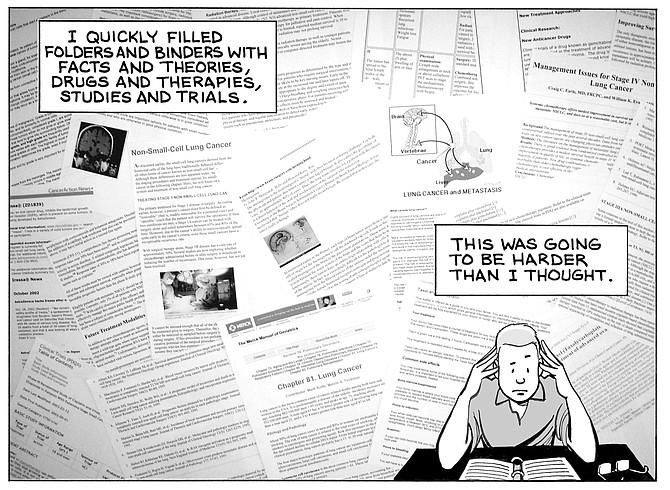
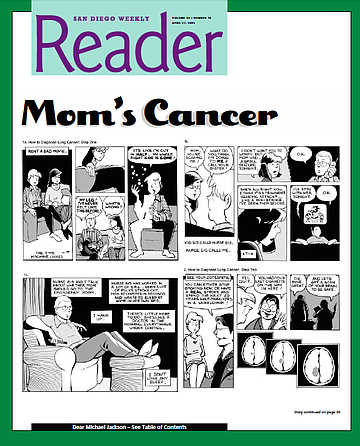
If your mom were diagnosed with cancer, how would you deal with it? Comic creator Brian Fies decided to use sequential art to help cope and deal with the struggle his mother had with the disease. Almost everyone who has read the comic agrees it's a powerful, evocative, poignant, and very human story. When the strip began, Jennifer Contino of the Pulse, an online magazine, approached the then-anonymous creator and asked about an interview, but Fies said he didn't want to do interviews until the story was completed. Mom's Cancer recently ended, so we've now got details from Fies on how this all came together.
Jennifer Contino: This was a very powerful story — mostly because of the subject matter but also because of the heart and emotion you put upon every page. How tough was it for you to tell your mom's story in this fashion?
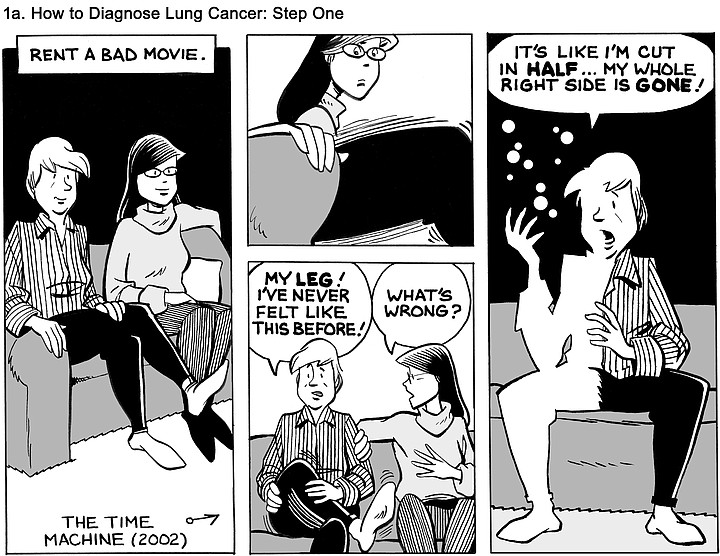
Brian Fies: When my mother was diagnosed with lung cancer we were hit with things that no one prepares you for, and I got the idea to somehow communicate these observations that I wish someone had shared with me. Then one day I took my mother to chemotherapy, and to pass the time, I sketched a cartoon of her dozing in her chair. I looked at it and thought, "Huh. Now that's something." I began taking notes, doing sketches, and basically trying to capture everything that seemed interesting about my family's experience. I don't think Mom's Cancer would work as prose, but as a comic everything came together for me.
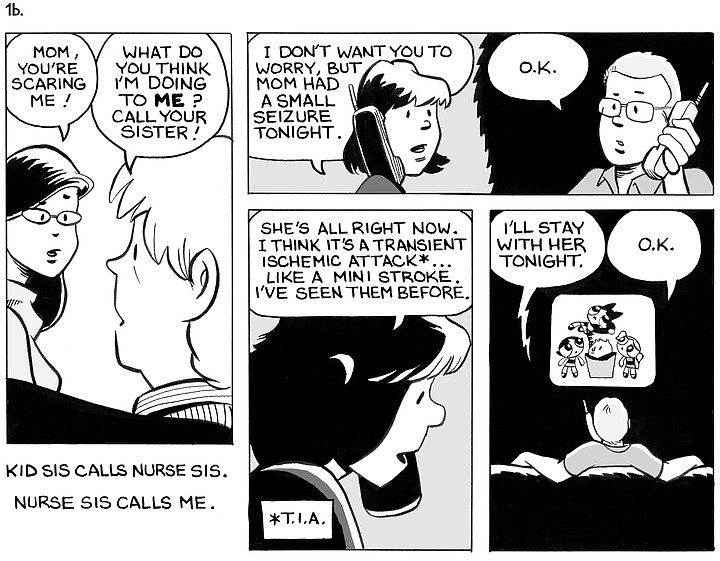
What got tough about doing Mom's Cancer wasn't so much the immediate emotional intensity of it but just the long, exhausting drain. For example, my wife and kids and I took our first trip to Europe last summer, and a friend gave me a blank sketchbook to take along. It was a nice idea, but I was so tired of trying to record every important moment of my family's life that I couldn't pick up the sketchbook once. I needed a vacation from being an observer.

Contino: How did working on this comic help you deal with what was going on in your life?
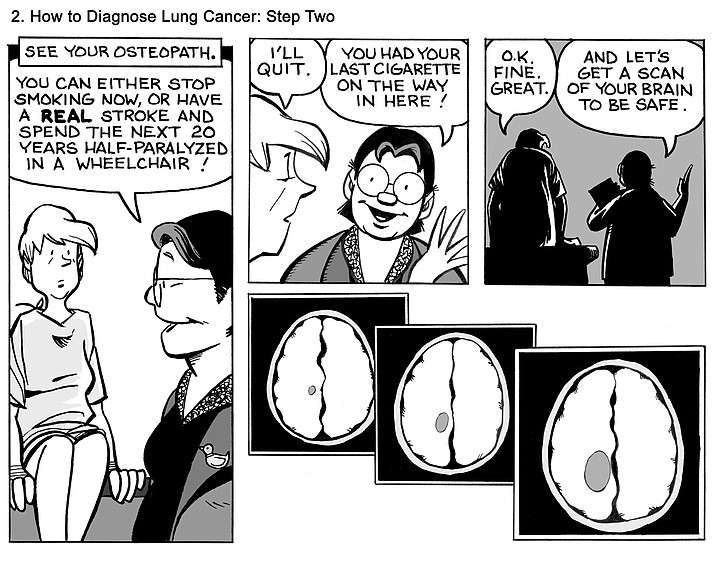
Fies: I think it helped a lot. The first thing my wife said was, "Well, at least it'll be good therapy for you." It gave me some emotional detachment, and sitting down and writing about these events helped sort them out and put them in perspective. I was taking something bad and trying to turn it into something good. It worked for me.
Contino: You didn't want to do any interviews or talk about the work until it was completed. Why?
Fies: Mostly cowardice.
At first, because no one else knew about it, including my family. The story was still in progress, and I didn't want my mother or sisters acting differently around me because they thought I was watching their every move. They didn't need that. I wanted to respect their privacy and preserve mine. In addition, I wanted to get the entire story done so it could be seen as a whole.
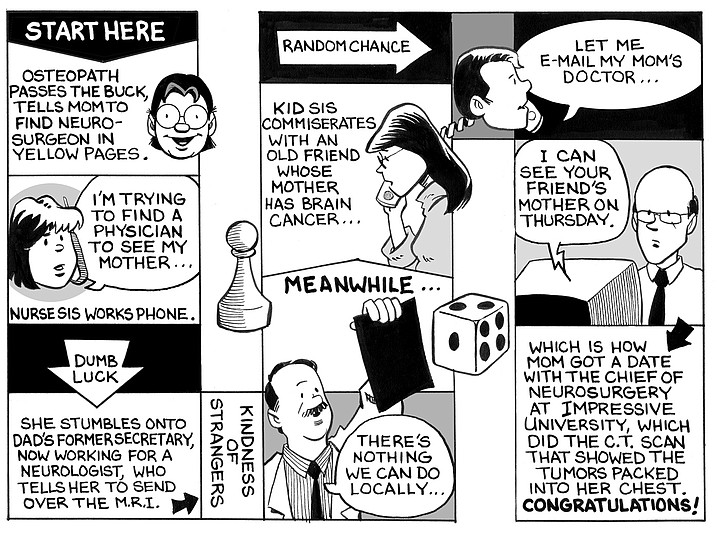
I initially put Mom's Cancer on the Web when it was about half done to solicit the opinions of some comic strip fans and cartoonists whose judgment I trusted. They gave me some great feedback, but what I didn't quite count on was that they'd tell two friends, and they'd tell two friends, and so on and so on.... Whatever attention it's gotten has been almost entirely word of mouth.
Plus, I wasn't much interested in getting my name out, because that wasn't really the point. I'm not being disingenuous or falsely modest — I want as many people to read Mom's Cancer as possible — but it didn't really add any value to the story to know it was written by a guy named Brian.
Anonymity reinforced the notion that it could be about any family anywhere.
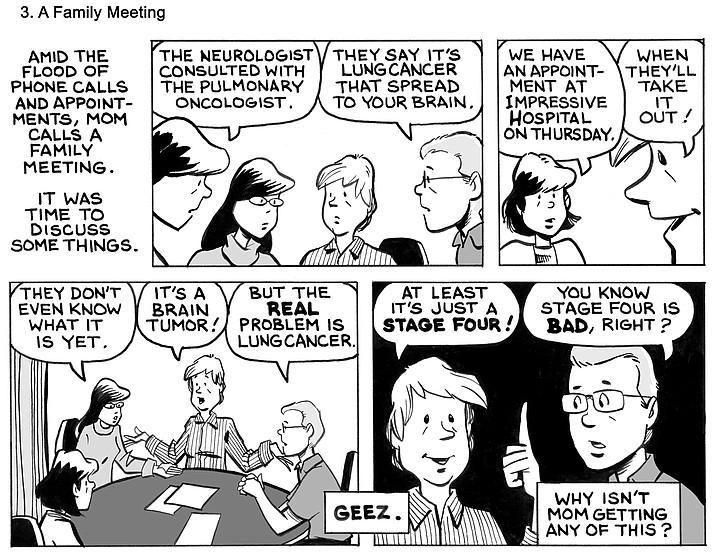
Contino: What did the rest of your family think about sharing this experience with the rest of the world via the World Wide Web?
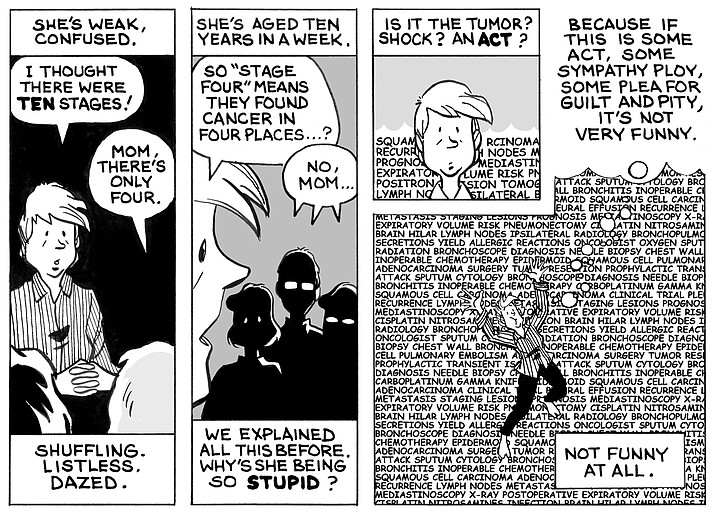
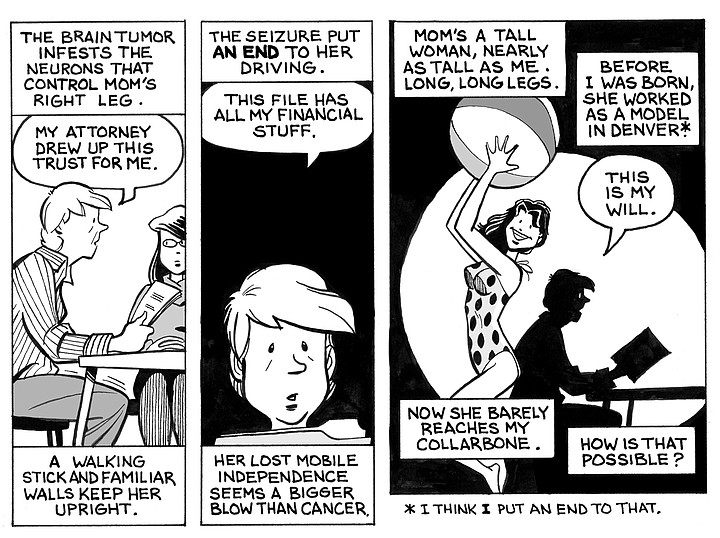
Fies: They reacted better than I'd hoped...or feared. Mom loved it. It meant a lot to my mother to find out that a church group in Texas was praying for her and that readers in Canada, Australia, the U.K., Spain, Peru, and Israel were pulling for her.
I knew my "Kid Sis" would get it. In fact, she told me she'd found her own creative outlet by writing a screenplay. We just looked at each other and said, "Oh, so that's how you're exorcising the demons." "Nurse Sis" was a tougher sell. I was surprised that her main concern was more professional than personal. She thought I'd mishandled some medical material and didn't want anyone to conclude she was a bad nurse. I knew we were all right when she started telling her friends about it.
Considering that my portrayals weren't entirely flattering, and I know they dispute my memories of some events, my family has been incredibly, unexpectedly supportive. They're my stealth marketing team.
Contino: How long did it take you to draw this autobiographical comic?

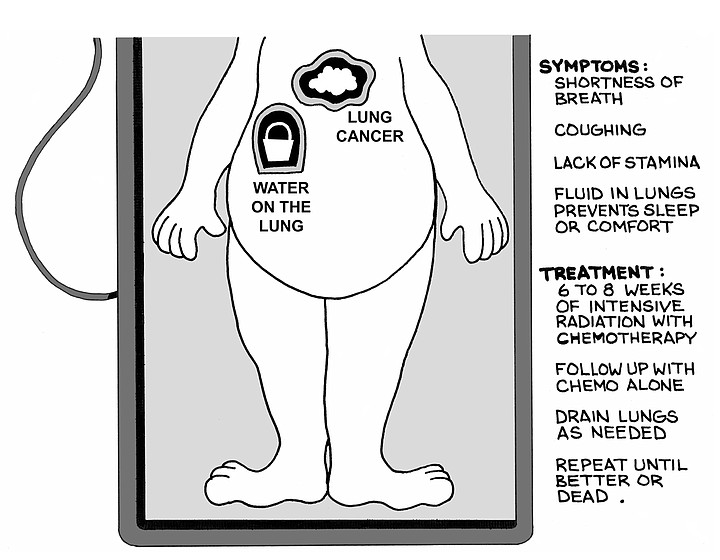
Fies: About a year and a half, roughly, in real time, although about six months behind the events I depicted. I had to work around a full-time job and family life, and in a good week I might get time to do three or four pages. In a busy week I didn't do any.
Contino: It all seems so concise — fits together so well. How did you determine which conversations — which parts of this story — to draw as a part of the final work and what to leave on the cutting-room floor?
Fies: I really appreciate that question; thanks for noticing. A ton of source material was distilled into Mom's Cancer. To begin with, I just recorded everything that caught my attention. Anything that surprised me; any "Hey, wait a minute" moments. Sometimes they hit you between the eyes, and sometimes you have to be alert for them. When you're busy living them you don't know how they'll fit together, so you catch as many as you can and sort them out later.

I edited ruthlessly. My guiding principle was that if it didn't focus like a laser on advancing my mother's story, it was out. For starters, I chopped out almost everything about me. There were a lot of other people, including my own wife and kids, who were important to Mom's life but not essential to propelling this story. I also knew it would fail if it were an iota more self-indulgent or maudlin than it had to be. If someone still finds it sickeningly sentimental, I won't argue, but I did my best to dial down the pathos.
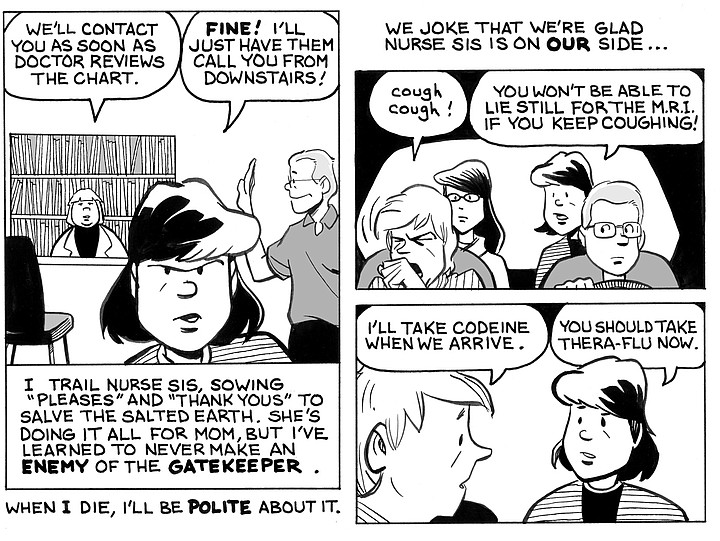
As script or sketches or even finished art, I probably had at least twice as much material as I ended up using. In the end, I'm afraid now that the story might be too lean, but when I look at what I cut out I can't imagine putting any of it back. I think it is what it is, for better or worse.
Contino: So much of what you described — especially the way doctors double-talk and confuse the patients — rings so true to home. How frustrated were you going through all of this with your sisters and your mother?

Fies: Frustrated, outraged, dumbstruck with disbelief. Once we got Mom to the oncology specialists, we thought she received excellent care. But even so, there were so many disconnects in how people relate to people and how the system relates to patients.
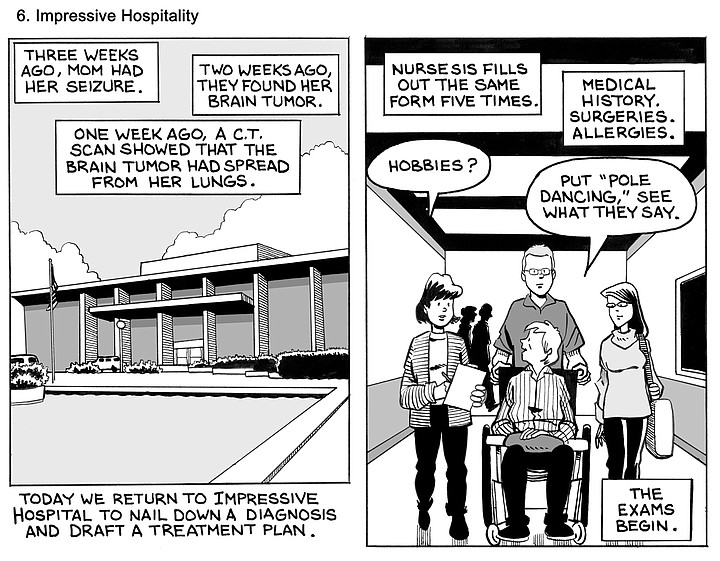
I think medical professionals forget that though they have hundreds of patients and see dozens of these routine little dramas every day, for each family and patient this is The Most Important Thing In Their Lives. We've never been through this before. We don't know things that they take for granted. We're in shock, with too much information coming too fast. It can be ridiculously hard to get a straight answer to a simple question. Taking an extra 20 minutes to explain everything very clearly at the first appointment could prevent days of confusion and uncertainty later.

On top of that are countless trivial frustrations. Your chart is always on someone else's desk. Someone will order tests you don't need or just took. Someone will insist you show up an hour early and then make you wait for four. Wal-Mart has better information-tracking technology than most hospitals.
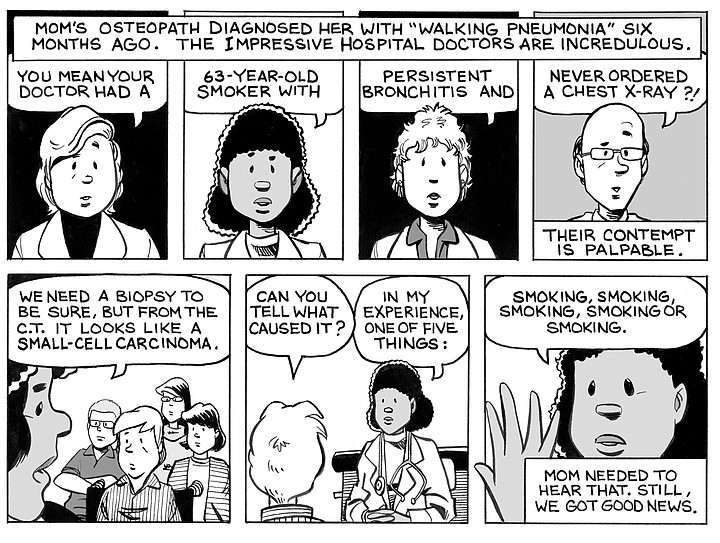
One of the most gratifying results of doing Mom's Cancer has been letters from medical professionals saying that it gave them real insight into the patient's point of view. A nursing instructor in Australia wrote to ask permission to include it with the training materials they send to nursing students working in remote rural areas. The idea that someone on the other side of the planet thinks my cartoons might help their students become better nurses blows me away. What could be better than that?
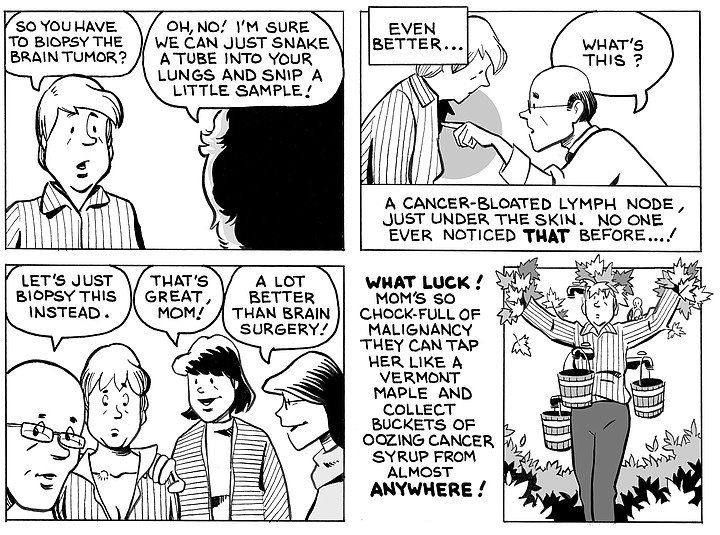
Contino: How did you decide which style to use to illustrate this story?
Fies: Another question I appreciate, because I put a lot of thought into it. Almost every other similarly themed comic I can think of is dark, anguished, grim, and gritty. I can do that, but I deliberately went the other way, toward light and clean — partly just to be contrary but also with an eye toward my audience.
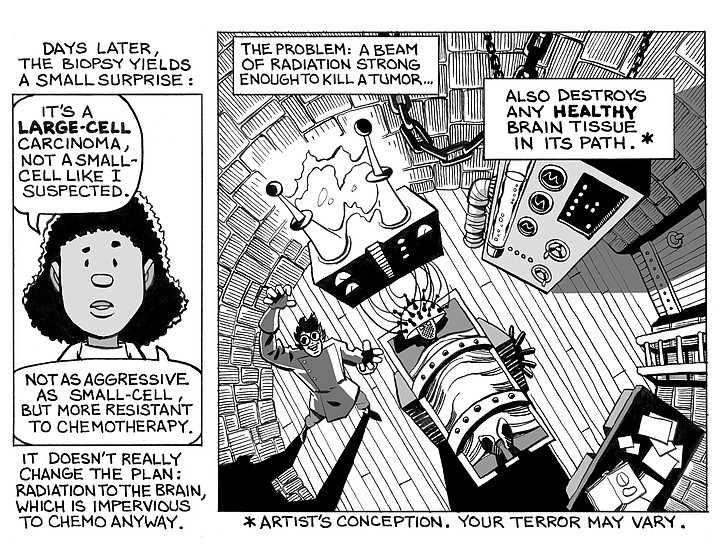
Accessibility is very important to me. I'm not aiming to impress a jaded, comics-savvy crowd that's seen it all. Mom's Cancer is drawn for grandparents and kids who've never read an adult comic or graphic novel. I wanted it to be an inviting, quick read, with an almost retro comic strip feel that I've described as "Family Circus in Hell." Let the folks get comfy and then hit them with this story, which I trusted enough to tell plain and straight — and even humorously — without slathering on the gothic gloom.
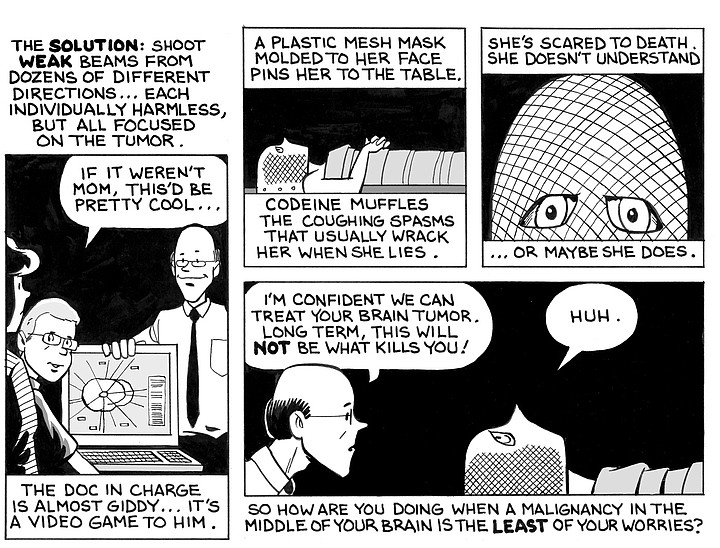
And honestly, some of my choices were driven by expediency. For the first half of Mom's Cancer, my goal was to get it done while my mother was still alive to see it, and I knew that wouldn't happen if I filled every panel with meticulously crosshatched bric-a-brac. I was working faster and looser than I might otherwise want to.
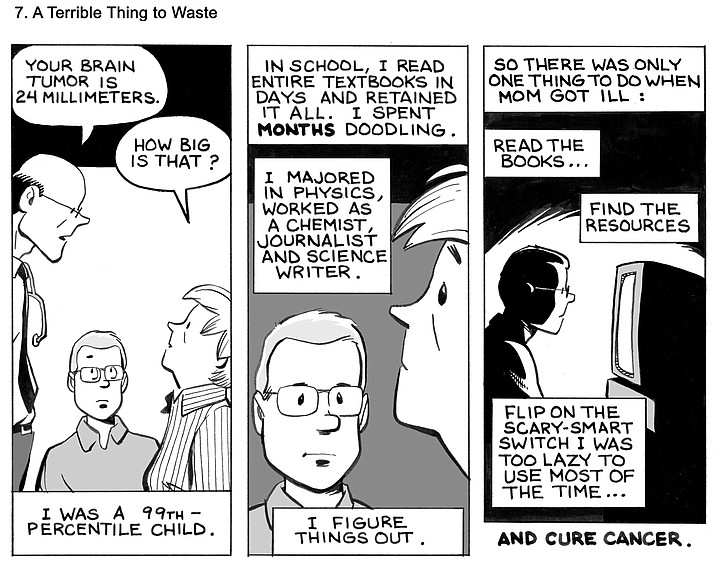
Frankly, I'm not sure I made the right decision. It's interesting that, within a medium that celebrates individual expression, there are a fair number of people who think a comic strip about cancer should look a certain way and react pretty badly when it doesn't. One of my favorite reviews was from a blogger who wrote something like, "The art is very clean and uncluttered, but I liked it anyway."
Contino: Who or what were some of your creative influences for Mom's Cancer?

Fies: That's a tough question. Most of the people whose art and writing I admire have nothing to do with cartooning. I know I need to mention Harvey Pekar — acknowledging that my 105 little pages don't amount to a pimple on the pinkie of his body of work — but except for his Letterman appearances, he was never high on my radar. Our storytelling couldn't be more different. I knew about Our Cancer Year but deliberately avoided reading it until after Mom's Cancer was finished. I may be fooling myself, but I'd like to think it would have turned out about the same anyway.

I've cartooned as long as I can remember and sort my influences into two groups: those I passively absorbed growing up and those I actively sought out later. The first group includes people like Charles Schulz, Stan Drake, Neal Adams, Gus Arriola, and John Buscema. The latter includes people like Winsor McCay, George Herriman, Milt Caniff, Roy Crane, Cliff Sterrett, and Will Eisner. My dad had several Pogo books from the 1950s that I devoured as a teenager, and if I had to point to one person and say, "That's everything you want in a cartoonist," it'd probably be Walt Kelly. Underground comics never really interested me, which probably accounts for the distance I feel from a lot of graphic novels that share similar sensibilities.
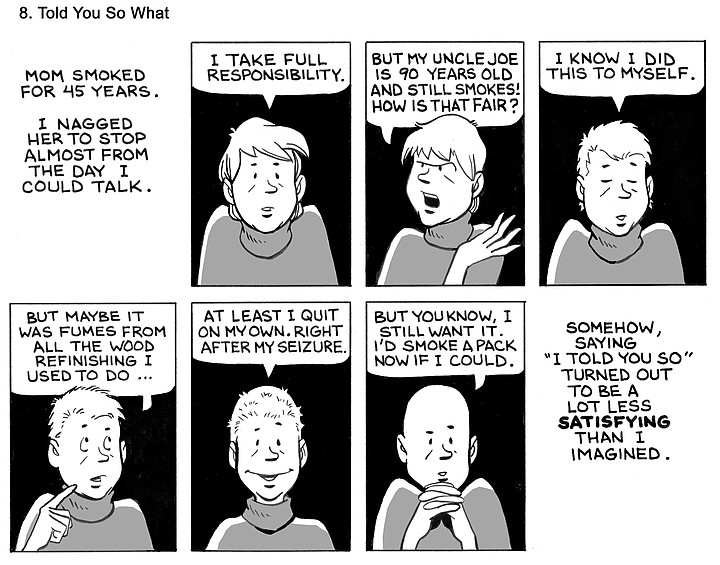
Contino: The places where you inserted a splash of color really set the pages apart from the rest of the work. Why did you use the gray tones instead of making this full color? How did you decide where to insert color and what to leave shades of gray, black, and white?
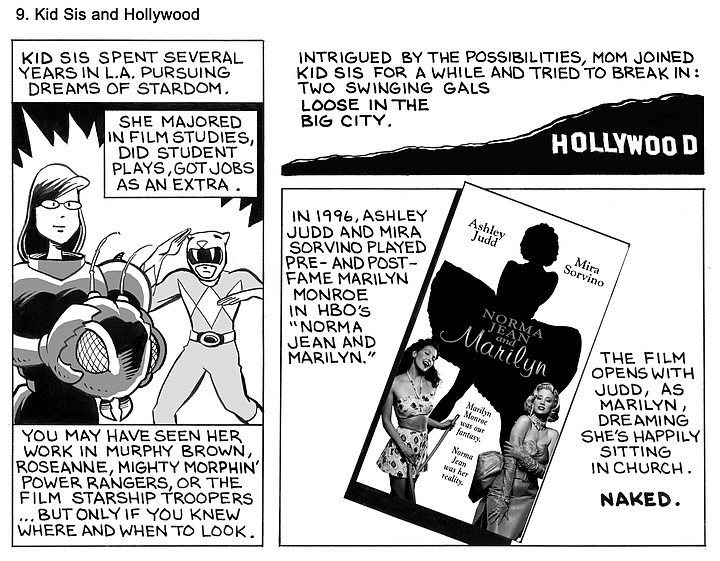
Fies: Part of the answer for going grayscale was, again, expediency, and part was artistic preference. I like black-and-white comic art for the same reason people continued to make black-and-white movies after the invention of Technicolor. I tried to be cognizant of how I used blacks, grays, and negative space, and I think a lot of that can get lost when buried in color.
I wanted to reserve color for when it really meant something: Kansas versus Oz. Even then, I was careful to keep my colors flat and, again, kind of retro. No airbrushing, modeling, etc., just slabs of tint like you'd see in the old Sunday funnies.

Contino: How did you keep your hope and spirits high while all of this was going on?
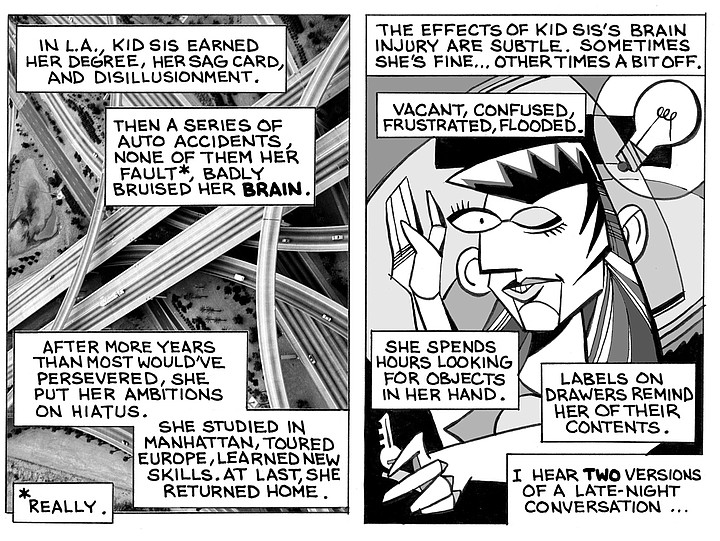
Fies: Well, I didn't necessarily keep my hope and spirits high. When I started Mom's Cancer I really thought it was going to have a different ending. That's one of the twists I enjoy about the story, that the universe still holds humbling surprises for Mr. Smarty-Pants Science Boy. But even when your hopes aren't high you just keep doing what you can, because, really, what choice do you have?

However, one thing I think was very important was my family's sense of humor. There were times we'd be at the cancer clinic laughing so loudly that the staff would come by and close our door. Stupid, dark humor. Once a neurologist was examining Mom by asking her to name everyday objects as he pointed to them: necktie, button, pen. And he points at the part of his eyeglasses that connects the lens to the earpiece. Mom goes blank. We all go blank. None of us knows what that thing is called. Turns out it's a "stem," and we all flunked the brain test. You can mine hours of low-grade comedy gold out of something like that.
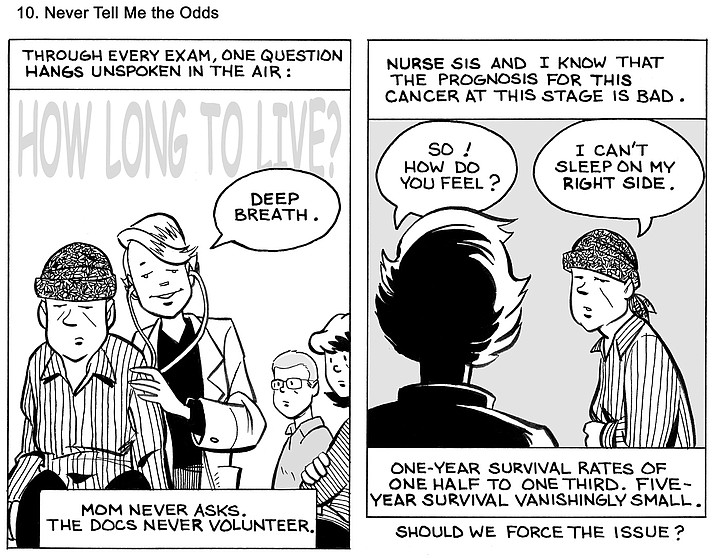
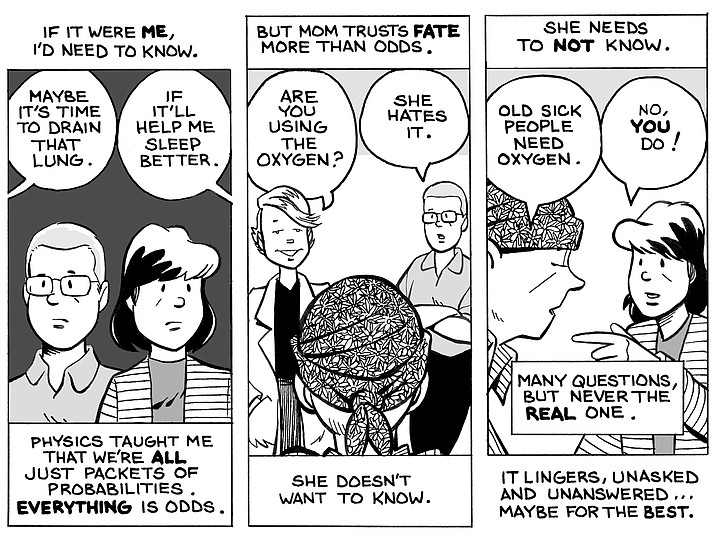
Contino: What plans do you have — if any — to release a comic book print version of this volume?
Fies: As I mentioned earlier, I do want as many people as possible to read Mom's Cancer. I'd very much like to see it in print and have begun working toward that. I think it'd make a swell trade paperback. Some of the usual publishing suspects have already told me thanks but no thanks, but I'm encouraged that a couple have actually contacted me first. Just feelers, nothing firm. I'm not sure I have the skills or temperament to self-publish, but it's certainly something I'd consider. I'm pretty sure I could sell a few copies to some Australian nurses.
Contino: What other projects are you working on?
Fies: Making decorations for a Girl Scout dance and cooking dinner.



If your mom were diagnosed with cancer, how would you deal with it? Comic creator Brian Fies decided to use sequential art to help cope and deal with the struggle his mother had with the disease. Almost everyone who has read the comic agrees it's a powerful, evocative, poignant, and very human story. When the strip began, Jennifer Contino of the Pulse, an online magazine, approached the then-anonymous creator and asked about an interview, but Fies said he didn't want to do interviews until the story was completed. Mom's Cancer recently ended, so we've now got details from Fies on how this all came together.
Jennifer Contino: This was a very powerful story — mostly because of the subject matter but also because of the heart and emotion you put upon every page. How tough was it for you to tell your mom's story in this fashion?

Brian Fies: When my mother was diagnosed with lung cancer we were hit with things that no one prepares you for, and I got the idea to somehow communicate these observations that I wish someone had shared with me. Then one day I took my mother to chemotherapy, and to pass the time, I sketched a cartoon of her dozing in her chair. I looked at it and thought, "Huh. Now that's something." I began taking notes, doing sketches, and basically trying to capture everything that seemed interesting about my family's experience. I don't think Mom's Cancer would work as prose, but as a comic everything came together for me.

What got tough about doing Mom's Cancer wasn't so much the immediate emotional intensity of it but just the long, exhausting drain. For example, my wife and kids and I took our first trip to Europe last summer, and a friend gave me a blank sketchbook to take along. It was a nice idea, but I was so tired of trying to record every important moment of my family's life that I couldn't pick up the sketchbook once. I needed a vacation from being an observer.

Contino: How did working on this comic help you deal with what was going on in your life?

Fies: I think it helped a lot. The first thing my wife said was, "Well, at least it'll be good therapy for you." It gave me some emotional detachment, and sitting down and writing about these events helped sort them out and put them in perspective. I was taking something bad and trying to turn it into something good. It worked for me.
Contino: You didn't want to do any interviews or talk about the work until it was completed. Why?
Fies: Mostly cowardice.
At first, because no one else knew about it, including my family. The story was still in progress, and I didn't want my mother or sisters acting differently around me because they thought I was watching their every move. They didn't need that. I wanted to respect their privacy and preserve mine. In addition, I wanted to get the entire story done so it could be seen as a whole.

I initially put Mom's Cancer on the Web when it was about half done to solicit the opinions of some comic strip fans and cartoonists whose judgment I trusted. They gave me some great feedback, but what I didn't quite count on was that they'd tell two friends, and they'd tell two friends, and so on and so on.... Whatever attention it's gotten has been almost entirely word of mouth.
Plus, I wasn't much interested in getting my name out, because that wasn't really the point. I'm not being disingenuous or falsely modest — I want as many people to read Mom's Cancer as possible — but it didn't really add any value to the story to know it was written by a guy named Brian.
Anonymity reinforced the notion that it could be about any family anywhere.

Contino: What did the rest of your family think about sharing this experience with the rest of the world via the World Wide Web?


Fies: They reacted better than I'd hoped...or feared. Mom loved it. It meant a lot to my mother to find out that a church group in Texas was praying for her and that readers in Canada, Australia, the U.K., Spain, Peru, and Israel were pulling for her.
I knew my "Kid Sis" would get it. In fact, she told me she'd found her own creative outlet by writing a screenplay. We just looked at each other and said, "Oh, so that's how you're exorcising the demons." "Nurse Sis" was a tougher sell. I was surprised that her main concern was more professional than personal. She thought I'd mishandled some medical material and didn't want anyone to conclude she was a bad nurse. I knew we were all right when she started telling her friends about it.
Considering that my portrayals weren't entirely flattering, and I know they dispute my memories of some events, my family has been incredibly, unexpectedly supportive. They're my stealth marketing team.
Contino: How long did it take you to draw this autobiographical comic?


Fies: About a year and a half, roughly, in real time, although about six months behind the events I depicted. I had to work around a full-time job and family life, and in a good week I might get time to do three or four pages. In a busy week I didn't do any.
Contino: It all seems so concise — fits together so well. How did you determine which conversations — which parts of this story — to draw as a part of the final work and what to leave on the cutting-room floor?
Fies: I really appreciate that question; thanks for noticing. A ton of source material was distilled into Mom's Cancer. To begin with, I just recorded everything that caught my attention. Anything that surprised me; any "Hey, wait a minute" moments. Sometimes they hit you between the eyes, and sometimes you have to be alert for them. When you're busy living them you don't know how they'll fit together, so you catch as many as you can and sort them out later.

I edited ruthlessly. My guiding principle was that if it didn't focus like a laser on advancing my mother's story, it was out. For starters, I chopped out almost everything about me. There were a lot of other people, including my own wife and kids, who were important to Mom's life but not essential to propelling this story. I also knew it would fail if it were an iota more self-indulgent or maudlin than it had to be. If someone still finds it sickeningly sentimental, I won't argue, but I did my best to dial down the pathos.

As script or sketches or even finished art, I probably had at least twice as much material as I ended up using. In the end, I'm afraid now that the story might be too lean, but when I look at what I cut out I can't imagine putting any of it back. I think it is what it is, for better or worse.
Contino: So much of what you described — especially the way doctors double-talk and confuse the patients — rings so true to home. How frustrated were you going through all of this with your sisters and your mother?

Fies: Frustrated, outraged, dumbstruck with disbelief. Once we got Mom to the oncology specialists, we thought she received excellent care. But even so, there were so many disconnects in how people relate to people and how the system relates to patients.

I think medical professionals forget that though they have hundreds of patients and see dozens of these routine little dramas every day, for each family and patient this is The Most Important Thing In Their Lives. We've never been through this before. We don't know things that they take for granted. We're in shock, with too much information coming too fast. It can be ridiculously hard to get a straight answer to a simple question. Taking an extra 20 minutes to explain everything very clearly at the first appointment could prevent days of confusion and uncertainty later.

On top of that are countless trivial frustrations. Your chart is always on someone else's desk. Someone will order tests you don't need or just took. Someone will insist you show up an hour early and then make you wait for four. Wal-Mart has better information-tracking technology than most hospitals.

One of the most gratifying results of doing Mom's Cancer has been letters from medical professionals saying that it gave them real insight into the patient's point of view. A nursing instructor in Australia wrote to ask permission to include it with the training materials they send to nursing students working in remote rural areas. The idea that someone on the other side of the planet thinks my cartoons might help their students become better nurses blows me away. What could be better than that?

Contino: How did you decide which style to use to illustrate this story?
Fies: Another question I appreciate, because I put a lot of thought into it. Almost every other similarly themed comic I can think of is dark, anguished, grim, and gritty. I can do that, but I deliberately went the other way, toward light and clean — partly just to be contrary but also with an eye toward my audience.

Accessibility is very important to me. I'm not aiming to impress a jaded, comics-savvy crowd that's seen it all. Mom's Cancer is drawn for grandparents and kids who've never read an adult comic or graphic novel. I wanted it to be an inviting, quick read, with an almost retro comic strip feel that I've described as "Family Circus in Hell." Let the folks get comfy and then hit them with this story, which I trusted enough to tell plain and straight — and even humorously — without slathering on the gothic gloom.

And honestly, some of my choices were driven by expediency. For the first half of Mom's Cancer, my goal was to get it done while my mother was still alive to see it, and I knew that wouldn't happen if I filled every panel with meticulously crosshatched bric-a-brac. I was working faster and looser than I might otherwise want to.

Frankly, I'm not sure I made the right decision. It's interesting that, within a medium that celebrates individual expression, there are a fair number of people who think a comic strip about cancer should look a certain way and react pretty badly when it doesn't. One of my favorite reviews was from a blogger who wrote something like, "The art is very clean and uncluttered, but I liked it anyway."
Contino: Who or what were some of your creative influences for Mom's Cancer?

Fies: That's a tough question. Most of the people whose art and writing I admire have nothing to do with cartooning. I know I need to mention Harvey Pekar — acknowledging that my 105 little pages don't amount to a pimple on the pinkie of his body of work — but except for his Letterman appearances, he was never high on my radar. Our storytelling couldn't be more different. I knew about Our Cancer Year but deliberately avoided reading it until after Mom's Cancer was finished. I may be fooling myself, but I'd like to think it would have turned out about the same anyway.

I've cartooned as long as I can remember and sort my influences into two groups: those I passively absorbed growing up and those I actively sought out later. The first group includes people like Charles Schulz, Stan Drake, Neal Adams, Gus Arriola, and John Buscema. The latter includes people like Winsor McCay, George Herriman, Milt Caniff, Roy Crane, Cliff Sterrett, and Will Eisner. My dad had several Pogo books from the 1950s that I devoured as a teenager, and if I had to point to one person and say, "That's everything you want in a cartoonist," it'd probably be Walt Kelly. Underground comics never really interested me, which probably accounts for the distance I feel from a lot of graphic novels that share similar sensibilities.

Contino: The places where you inserted a splash of color really set the pages apart from the rest of the work. Why did you use the gray tones instead of making this full color? How did you decide where to insert color and what to leave shades of gray, black, and white?

Fies: Part of the answer for going grayscale was, again, expediency, and part was artistic preference. I like black-and-white comic art for the same reason people continued to make black-and-white movies after the invention of Technicolor. I tried to be cognizant of how I used blacks, grays, and negative space, and I think a lot of that can get lost when buried in color.
I wanted to reserve color for when it really meant something: Kansas versus Oz. Even then, I was careful to keep my colors flat and, again, kind of retro. No airbrushing, modeling, etc., just slabs of tint like you'd see in the old Sunday funnies.

Contino: How did you keep your hope and spirits high while all of this was going on?

Fies: Well, I didn't necessarily keep my hope and spirits high. When I started Mom's Cancer I really thought it was going to have a different ending. That's one of the twists I enjoy about the story, that the universe still holds humbling surprises for Mr. Smarty-Pants Science Boy. But even when your hopes aren't high you just keep doing what you can, because, really, what choice do you have?

However, one thing I think was very important was my family's sense of humor. There were times we'd be at the cancer clinic laughing so loudly that the staff would come by and close our door. Stupid, dark humor. Once a neurologist was examining Mom by asking her to name everyday objects as he pointed to them: necktie, button, pen. And he points at the part of his eyeglasses that connects the lens to the earpiece. Mom goes blank. We all go blank. None of us knows what that thing is called. Turns out it's a "stem," and we all flunked the brain test. You can mine hours of low-grade comedy gold out of something like that.


Contino: What plans do you have — if any — to release a comic book print version of this volume?
Fies: As I mentioned earlier, I do want as many people as possible to read Mom's Cancer. I'd very much like to see it in print and have begun working toward that. I think it'd make a swell trade paperback. Some of the usual publishing suspects have already told me thanks but no thanks, but I'm encouraged that a couple have actually contacted me first. Just feelers, nothing firm. I'm not sure I have the skills or temperament to self-publish, but it's certainly something I'd consider. I'm pretty sure I could sell a few copies to some Australian nurses.
Contino: What other projects are you working on?
Fies: Making decorations for a Girl Scout dance and cooking dinner.
Comments